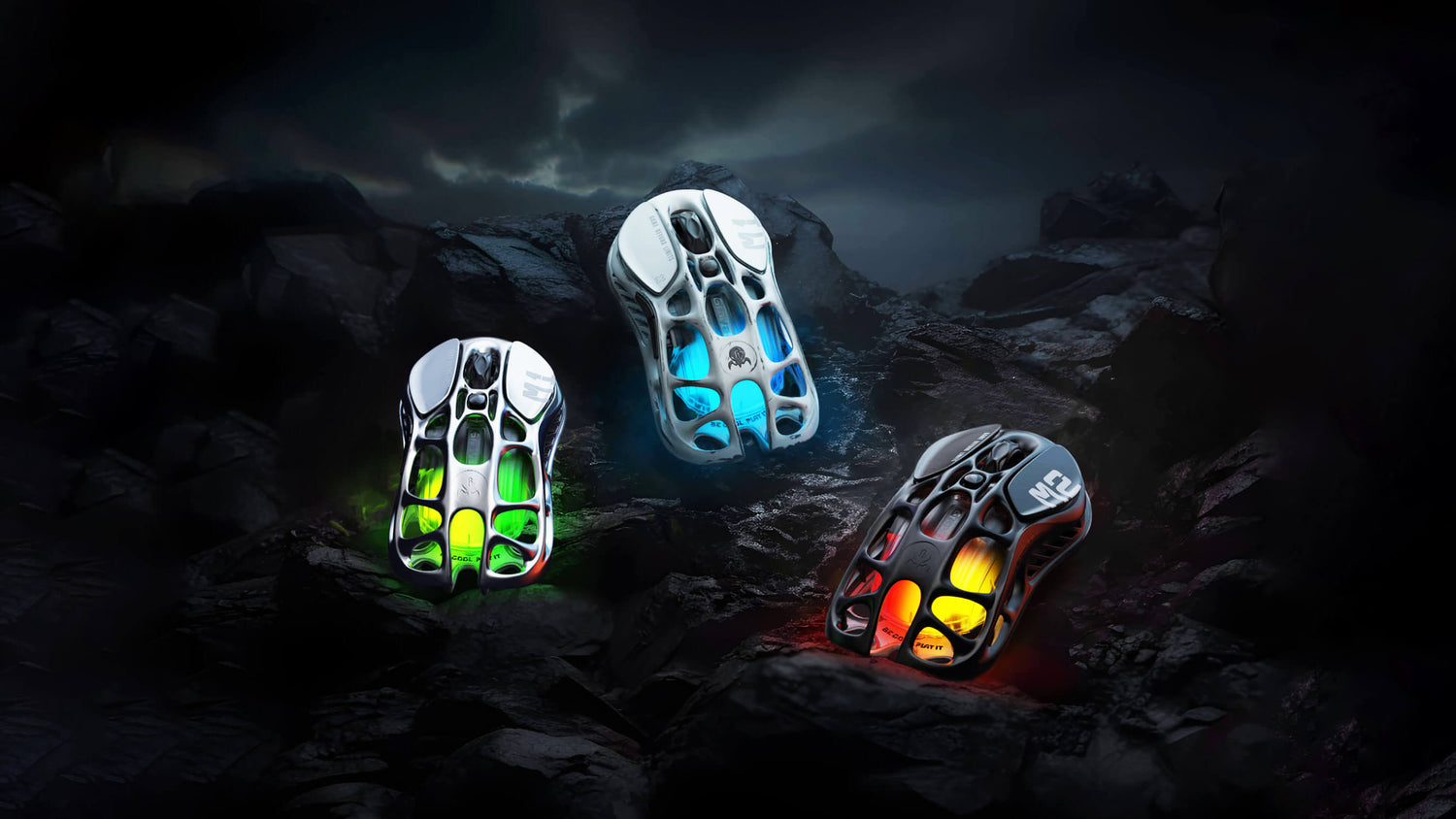When looking for the perfect gaming mouse, the choice of material is crucial. Do you prefer the lightweight agility of a plastic mouse, or are you inclined toward the stable precision of a magnesium alloy mouse? This decision can significantly enhance your gaming experience, so let's dive into the details to help you make an informed choice.
Do Materials Matter in a Gaming Mouse?
The significance of materials in gaming mice cannot be overstated, for they directly influence the mouse's weight, texture, durability, and even its heat dissipation capabilities. While traditional plastic mice offer versatility and cost-effectiveness, magnesium alloy mice are emerging as a symbol of premium quality and enhanced performance. The choice of material affects the tactile experience, response time, and overall endurance of the mouse, factors that are crucial for gamers seeking precision and reliability.
Magnesium Alloy vs. Plastic Gaming Mouse: Appearance
Magnesium alloy gaming mice, with their contemporary designs, offer a visually striking presence. These mice frequently showcase a sleek, minimalist look, featuring clean lines and a polished metallic finish that sets them apart from the more common plastic variants. The lustrous sheen and finely textured surface of magnesium alloy lend these mice a luxurious appearance, often associated with high-end gaming equipment.
In contrast, plastic gaming mice provide a vast spectrum of customization options. They are available in an array of colors, from vibrant hues to subtle tones, allowing gamers to choose a mouse that resonates with their personal style. Additionally, plastic's malleability enables manufacturers to create an assortment of shapes and sizes, leading to ergonomic designs that conform to various hand sizes and grip styles. This flexibility in design ensures that there is a plastic mouse to suit every gamer's individual preference, whether they prioritize comfort, style, or a balance of both.
Plastic vs. Magnesium Gaming Mouse: Grip and Comfort
Plastic gaming mice are widely recognized for their light weight, which reduces hand fatigue during prolonged gaming sessions. To enhance grip, these mice often feature surfaces coated with rubber or textured materials, providing a non-slip hold that is crucial during intense gameplay. This adaptability in texture allows for a tailored gaming experience, catering to those who prefer a softer touch or require extra grip.
Magnesium alloy gaming mice, on the other hand, bring a distinct advantage to the table. The metal composition of these mice gives them a naturally cool feel to the touch, which is particularly advantageous during long gaming sessions where hand warmth can become an issue. This coolness helps maintain a consistent grip by reducing sweat build-up, a common concern among serious gamers. Furthermore, the heftier weight of magnesium alloy mice contributes to a sense of stability and controlled movement. This added weight is not cumbersome but rather enhances precision, allowing for more deliberate and accurate cursor movements. Such precision is invaluable in gaming genres that demand meticulous aim and swift reactions.
Magnesium Alloy vs. Plastic Gaming Mouse: Heat Dissipation
The issue of heat dissipation in gaming mice is crucial, especially during extended periods of play. Magnesium alloy is renowned for its excellent thermal conductivity, which plays a pivotal role in heat management. This material efficiently channels away the heat generated by the user's hand and the internal components of the mouse. Consequently, magnesium alloy gaming mice remain remarkably cooler compared to their plastic counterparts. This is a significant advantage for gamers who suffer from sweaty palms, a common distraction that can affect grip and overall performance. The cool surface of a magnesium mouse ensures a more consistent and comfortable experience, allowing gamers to maintain optimal performance levels without the inconvenience of a slippery or uncomfortable grip.
Plastic vs. Magnesium Gaming Mouse: Durability and Maintenance
Magnesium alloy gaming mice boast a robust construction, offering superior resistance to everyday wear and tear. Unlike plastic, magnesium alloy is less susceptible to cracking under pressure or stress, making it an ideal choice for gamers who demand a durable and long-lasting tool. These mice are built to endure the rigors of intense gaming sessions, ensuring reliability and consistency over time. However, it is important to note that magnesium alloy can be prone to dents and scratches if not handled with care. Therefore, users may need to exercise a bit more caution in their handling and storage.
Plastic gaming mice, while generally less sturdy than magnesium alloy, offer their own set of advantages in terms of durability and maintenance. These mice are often more affordable and easily replaceable, making them a practical choice for gamers on a budget or those who prefer to frequently upgrade their gear. Plastic surfaces are also less likely to show minor scratches and are often designed to resist the accumulation of dirt and grime. This makes plastic mice easier to clean and maintain, requiring less meticulous care compared to their magnesium alloy counterparts. For gamers who prioritize ease of maintenance and cost-effectiveness, plastic gaming mice present a compelling option.
Magnesium Alloy vs. Plastic Gaming Mouse: Gaming Experience
The impact of the mouse material on the gaming experience is substantial and can be the deciding factor in a gamer's performance. Magnesium alloy gaming mice offer a distinct feel of stability and precision, primarily due to their increased weight and structural rigidity. This physical solidity translates to enhanced accuracy and control, which is especially beneficial in games requiring precise aim and steady cursor movement. For instance, in first- person shooter (FPS) games like "Call of Duty" or "Counter- Strike," the steady hand provided by a magnesium alloy mouse can improve aiming accuracy, making each shot count. Similarly, in strategy games like "StarCraft," where precise unit selection and movement are key, the stability of a magnesium mouse can be a significant advantage.
In contrast, plastic gaming mice are notably lighter, which can be a boon for games that demand swift and rapid movements. This reduced weight allows for quicker reflexes and faster cursor speeds, ideal for fast-paced action games or battle royales like "Fortnite" or "Apex Legends," where agility and quick reactions are crucial. However, the trade- off for this speed is potentially less precision. The lightness of the plastic mouse might lead to overshooting targets or less controlled movements, which can be a drawback in situations where fine control is needed.
So, the choice between a magnesium alloy and a plastic gaming mouse boils down to the gamer's preference for speed or control. Players who value precision and steadiness in their gameplay might lean towards magnesium alloy mice, while those who prioritize agility and quick movements might find plastic mice more suited to their style.
Plastic vs. Magnesium Gaming Mouse: Which is Right for You?
Following the insights provided earlier, you should've had a clearer idea about choosing between Plastic vs. Magnesium Gaming Mice. If you lean towards a plastic gaming mouse, then the GravaStar Mercury M2 Wireless Gaming Mouse is an ideal choice for you.
The GravaStar Mercury M2 is a great example of plastic gaming mice's versatility and innovation. It features a unique dual-layer structure with a skeletal design that not only provides an appealing aesthetic but also enhances heat dissipation, reducing sweat accumulation during intense gaming sessions. The mouse is lightweight, weighing just 79g, which minimizes fatigue and maintains comfort over prolonged use. It boasts five types of adjustable ambient lighting effects, adding a personalized touch to your gaming setup.
In terms of performance, the M2 is equipped with the PAW3395 sensor and supports up to 26000 DPI, ensuring precise and responsive tracking. It offers three connection modes – Bluetooth, wireless 2.4G, and wired – catering to various user preferences. The mouse also features five customizable buttons and four onboard configuration profiles, allowing for extensive customization to suit any gaming style.
Or if your preference is for a magnesium gaming mouse, the GravaStar Mercury M1 Pro Wireless Gaming Mouse will be your go-to option.
The GravaStar Mercury M1 Pro is an embodiment of the advanced capabilities of magnesium alloy gaming mice. It stands out with its unique war-damaged handmade craft, giving it a distinct and rugged appearance. This model is slightly heavier than the M2, at 89g, which contributes to its stable and precise handling. The integrated PAW3395 sensor and Nordic 52833 main control support up to 26000 DPI, providing top-tier tracking performance.
The M1 Pro features ultra-low latency of 0.25ms with its 4K receiver module, making it an excellent choice for gamers who need the utmost precision and responsiveness. Like the M2, it offers customizable lighting effects and button configurations but with the added durability and premium feel of a magnesium alloy shell.
To equip you with a good grip on the two exemplary mice, hence a wise decision, please continue to refer to the following comparison table:
|
Feature/Specification |
GravaStar Mercury M2 |
GravaStar Mercury M1 Pro |
|
Material |
Plastic shell |
Magnesium Alloy Shell |
|
Weight |
79g |
88g |
|
Sensor |
PAW3395DM |
PAW3395DM |
|
DPI Range |
100-26000 DPI |
100-26000 DPI |
|
Maximum Acceleration |
650 IPS |
650 IPS |
|
Maximum Speed |
50G |
50G |
|
USB Reporting Rate |
1000 Hz (1ms) |
4000 Hz (0.25ms) |
|
Battery Capacity |
400mAh |
400mAh |
|
Connection Modes |
Bluetooth, Wireless 2.4G, Wired |
Bluetooth, Wireless 2.4G, Wired |
|
Customizable Buttons |
5 |
5 |
|
Ambient Lighting Effects |
Five types, adjustable |
Five types, adjustable |
|
Design Features |
Skeletal hollow-out design |
Skeletal hollow-out design |
|
Foot Pads |
Teflon |
Teflon |
|
System Support |
Windows XP/Win7+ |
|
|
Special Features |
Lightweight, Comfortable |
Ultra-low latency, Premium feel |
Conclusion
In conclusion, choosing between a magnesium alloy and a plastic gaming mouse comes down to your personal gaming preferences and style. The GravaStar Mercury M2's plastic design offers lightweight agility and customizable aesthetics, ideal for gamers seeking speed and flair. Meanwhile, the GravaStar Mercury M1 Pro's magnesium alloy construction delivers a premium feel with enhanced precision and durability, perfect for those who prioritize stability and control.
Assess your gaming needs, and select the mouse that will elevate your gaming experience to the next level. Click here to explore and purchase your ideal GravaStar gaming mouse now.







Leave a comment
This site is protected by hCaptcha and the hCaptcha Privacy Policy and Terms of Service apply.